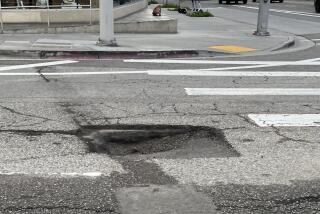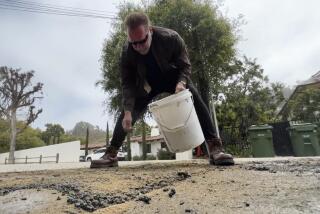HOME IMPROVEMENT : Driveway Doctoring: Filling, Patching, Packing, Sealing
Maintaining an asphalt driveway, if it was originally installed with at least a 4-inch depth over a good subbase, requires simple periodic maintenance of filling minor cracks that may develop and cosmetic sealing.
But driveways exposed to a lot of extreme weather, or those with a relatively shallow thickness will require more attention. Here are specific repair techniques for common driveway problems.
To repair cracks, use blacktop filler. This material comes in a cartridge and is used for cracks up to one-quarter-inch wide. Brush or vacuum loose material out of the crack, then lay in a continuous bead of filler. Allow it to set for about 10 minutes, then stroke over it with a putty knife to level and firm the bead to the crack’s edges. If the crack is more than one-half-inch deep, it should first be packed with sand to within one-quarter-inch of the surface.
A large pothole in the driveway is repaired with cold-mix, an asphalt-based filler that has larger aggregate than driveway patching compound. Typically, it comes in a 60- to 70-pound bag.
Use a cold chisel and hammer to chop out crumbling pavement until the pothole is rimmed with a clean, firm edge. If possible, undercut the hole slightly to lock the patch in place. Dig down until you get to a solid surface and remove loose debris from the hole’s bottom. Shovel the mix into the hole, mounding it so it’s about a half-inch higher than the surrounding surface. Compact the mound by tamping with a block of 2-by-4.
You can also pack the cold-mix by placing a scrap piece of plywood over the mound and driving back and forth over it with the front wheels of your car. Deep potholes should be filled and tamped in layers. Add some mix, tamp, then add more mix and tamp.
A coat of waterproof blacktop sealer, applied every two or three years, will protect the driveway from the sun and rain, and will improve its appearance.
The sealer comes in 5-gallon cans and usually needs only to be stirred before use. Read the product label to determine how much area it will cover. Usually this ranges between 200 and 300 square feet, depending on the porosity of the surface. Apply the sealer with a long-handled applicator that has a squeegee on one side and a brush on the other. Roller applicators are also available.
First, pour enough sealer from the can to work a 3- or 4-foot-wide strip across the driveway. Using the squeegee side of the applicator, spread the sealer across the driveway, working it into all tiny cracks and crevices. When the strip has been covered, flip to the brush side and use it to level the coating and smooth the ridges left by the squeegee. Work the brush at right angles to the path worked by the squeegee.
Don’t leave puddles of sealer and don’t spread it too thin. It’s best to apply two coats. Read the label to determine how long to allow the sealer to dry before recoating.


